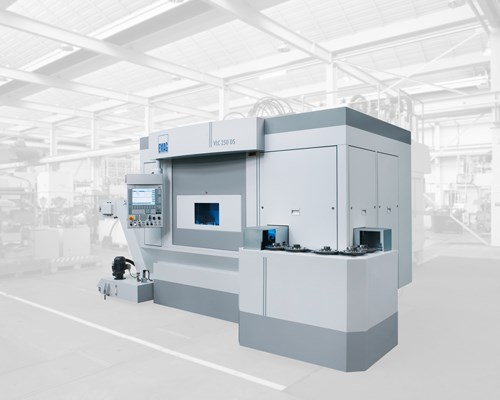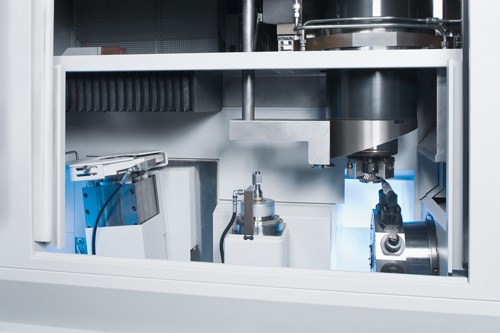Combining Hard Turning and Grinding
A combination machine that is capable of both turning and grinding work in a single setup might provide the capabilities a shop needs to address an ever changing work flow.
When a shop is in the market for new equipment, it generally has a certain need that a particular technology will fill. But over time, those needs can change, and certain specialized equipment may no longer be as useful to that shop. Today’s advanced technology allows machine tool builders to provide flexible, highly productive equipment that often gives shops multilayered capabilities. Such equipment allows a shop to adapt more readily to varying work. A machine designed under a platform concept—customizable for individual requirements while allowing simple reconfiguration for future demands—better prepares a shop for upcoming opportunities. During tough economic times, such features become even more important.
If a shop has sufficient capabilities for its turning requirements, but new jobs begin coming in that require some grinding work, the shop may find a need to invest in an additional machine. But if this grinding work is minimal and these workpieces are only produced in small or medium batch sizes, the purchase of a grinding machine may not be justified. A combination machine that is capable of both the turning and grinding work in a single setup could be the solution.
Blending Processes
EMAG now offers the VLC 250 DS turning and grinding center, combining the advantages of vertical hard turning with those of grinding. This machine is reconfigurable throughout its life cycle, providing adaptability to a shop’s changing requirements. By combining hard turning and grinding, throughput, transport times and storage periods can be substantially reduced to shorten overall cycle times.
The machine features a vertical work spindle and tools positioned below the workpiece to allow the turning and grinding chips to fall unhindered. All machine modules are designed to be mechanically sturdy and vibration resistant. The machine base is Mineralit polymer concrete for vibration damping, and the work spindle is designed to form an integral part of a sturdy quill that carries out its Z-axis movement on a high precision, hydrostatic guideway.
The tooling systems are anchored in the machine base and provide a stable basis for demanding turning and grinding operations. This design contributes to time-saving hard pre-turning work and achieving the best surface finish with a hard finish-turning or grinding operation. The number and design of the stationary tooling systems can be chosen to suit the individual machining requirement. Continuous monitoring of the machine temperature ensures a high degree of thermal stability. A cooling unit maintains suitable operating temperatures. The pickup technique used with the machine eliminates the need for a gantry loader or other loading device that would involve time-consuming resetting work.
Quality Control
The VLC 250 DS is designed to handle complex manufacturing processes, from turning work at high chip removal rates to gentler grinding operations. By offering complete machining in a single setup, it eliminates reclamping errors. Measuring operations can be included as well to ensure optimal integration of quality control functions into the overall process. The measuring probe is located between the machining area and the pickup station, clear from the ingress of chips and coolant. Because the workpiece remains clamped during the gaging process, intermediate measurements can also be taken.
Related Content
Junker Grinding Machines Feature Modular Design
The Platform 3 series of modular grinding machines is designed to provide increased flexibility and cost-effectiveness.
Read MoreAutomation in the Alps: Studer AG Unveils New Grinding Concepts
Studer AG, member company of United Grinding, held its annual press conference at its Swiss Alps location earlier this month to announce its new automatic loaders to accompany its existing grinding machines as well as other offerings and automation features.
Read MoreShould You Bring Tool Regrinding In-House?
In some situations, the potentially high investment in an in-house tool grinding process can be justified with a relatively fast ROI. (Includes video.)
Read MoreGrindstar Replaces Turning With Efficient Grinding
PMTS 2023: The Grindstar machine uses a method that enables the entire workpiece contour to be ground in a single processing operation.
Read MoreRead Next
Vertical Turning Upside Down
Using the main spindle for double-duty machining and workpiece load/unload makes sense. It’s a simple idea that has grown in sophistication from turning to multitasking. This article looks at the state of the art using inverted vertical turning for precision volume production.
Read MoreEmerging Leaders Nominations Now Open
Here’s your chance to highlight a young person in your manufacturing business who is on the path to be a future leader moving your company forward.
Read More5 Aspects of PMTS I Appreciate
The three-day edition of the 2025 Precision Machining Technology Show kicks off at the start of April. I’ll be there, and here are some reasons why.
Read More

























